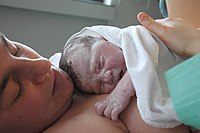
Plasma Concentrations of Long Chain N-3 Fatty Acids in Early and Mid-Pregnancy and Risk of Early Preterm Birth
Sign Up to like & getrecommendations! Published in 2018 at "EBioMedicine"
DOI: 10.1016/j.ebiom.2018.07.009
Abstract: Background Fish oil supplementation has been shown to delay spontaneous delivery, but the levels and clinical significance remain uncertain. We examined the association between plasma fatty acids quantified in pregnancy and subsequent risk of early… read more here.
Keywords: early preterm; risk; preterm birth; epa dha ... See more keywords

Relationship between early preterm birth (22-33 weeks) and late preterm birth (34-36 weeks) with the characteristics of sociodemography in primiparous and multiparous.
Sign Up to like & getrecommendations! Published in 2020 at "Enfermeria clinica"
DOI: 10.1016/j.enfcli.2019.07.156
Abstract: OBJECTIVE To determine the relationship between early preterm birth (22-33 weeks) and late preterm birth (34-36 weeks) labor with sociodemographic characteristics in primiparous and multiparous mothers. METHODS Design of observational analysis on 134 mothers after… read more here.
Keywords: preterm birth; birth; early preterm; birth weeks ... See more keywords

The effects of combined modalities of prefeeding stimulation on feeding progression, length of stay and weight gain in early preterm babies
Sign Up to like & getrecommendations! Published in 2020 at "Journal of Neonatal Nursing"
DOI: 10.1016/j.jnn.2020.04.005
Abstract: Abstract Study purpose Sensorimotor interventions in preterm neonates help to tackle feeding problems. This study was aimed to find out whether combined modalities of prefeeding stimulation were better than the conventional methods of kangaroo mother… read more here.
Keywords: prefeeding stimulation; preterm babies; early preterm; combined modalities ... See more keywords

Influence of assisted reproductive technologies on maternal and neonatal outcomes in early preterm deliveries.
Sign Up to like & getrecommendations! Published in 2019 at "Journal of gynecology obstetrics and human reproduction"
DOI: 10.1016/j.jogoh.2019.03.008
Abstract: INTRODUCTION Compared to spontaneous conception (SC), pregnancies conceived through assisted reproductive technologies (ART) carry worse pregnancy and neonatal outcomes. Evidences focused on preterm births are limited. Early preterm delivery is a critical situation for medical… read more here.
Keywords: pregnancy; preterm; delivery; early preterm ... See more keywords

Microbial Analysis of Umbilical Cord Blood Reveals Novel Pathogens Associated with Stillbirth and Early Preterm Birth
Sign Up to like & getrecommendations! Published in 2022 at "mBio"
DOI: 10.1128/mbio.02036-22
Abstract: Stillbirth accounts for half of all perinatal mortality, but the underlying cause of a substantial portion of all cases remains elusive. We examined the umbilical cord blood microbiome in stillbirths (n = 60) and live births (n = 176)… read more here.
Keywords: blood; early preterm; birth; cord blood ... See more keywords

Altered Gut Microbiome and Fecal Immune Phenotype in Early Preterm Infants With Leaky Gut
Sign Up to like & getrecommendations! Published in 2022 at "Frontiers in Immunology"
DOI: 10.3389/fimmu.2022.815046
Abstract: Intestinal barrier immaturity, or “leaky gut”, is the proximate cause of susceptibility to necrotizing enterocolitis in preterm neonates. Exacerbated intestinal immune responses, gut microbiota dysbiosis, and heightened barrier injury are considered primary triggers of aberrant… read more here.
Keywords: immune; maturation; early preterm; preterm ... See more keywords

SLC38A4 Amino Acid Transporter Expression Is Significantly Lower in Early Preterm Intrauterine Growth Restriction Complicated Placentas
Sign Up to like & getrecommendations! Published in 2022 at "International Journal of Molecular Sciences"
DOI: 10.3390/ijms24010403
Abstract: Intrauterine growth restriction (IUGR), predominantly caused by placental insufficiency, affects partitioning of nutrients to the fetus. The system A sodium-coupled transporters (SNAT or SLC38), of types A1, A2, and A4, control non-essential amino acid uptake… read more here.
Keywords: intrauterine growth; growth restriction; transporter; preterm ... See more keywords